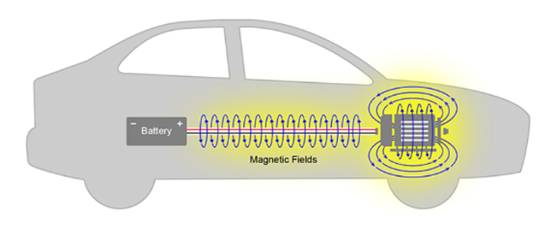Do you need a Hall effect sensor or an inductive sensor in your car?

Hall effect sensors in electric vehicles
From determining the position of the steering wheel, pedals and seats to setting various valves, knobs and actuators, position sensors are a common feature in modern cars. Traditionally, Hall effect sensors are often used for this because they have many advantages, including high reliability (as they work without physical contact) and high speed operation. However, electric vehicles operate in a very different environment from the traditional internal-combustion-powered vehicles it is gradually replacing, which poses problems for the continued use of Hall effect sensors. In this article, we review the operation of the Hall Effect sensor and explain why it is not suitable for use in electric vehicles. Then, we'll show how inductive position sensors work and what makes them a better choice for position sensing applications in electric vehicles.
Problems with the use of Hall effect sensors in electric vehicles
The principle of Hall effect sensor is to generate a small voltage by sensing the magnetic field intensity of the permanent magnet target. The output voltage can be used to measure the distance between a magnet and a Hall effect integrated circuit (IC). However, if other magnetic products in the vicinity of the Hall IC, there will be problems. If this happens, the sensor output voltage is not reliable. To prevent this from happening in automotive applications, shielding is often used to protect the sensor from stray magnetic fields in the vehicle. While this approach is satisfactory in conventional vehicles, electric vehicles pose a more serious challenge to Hall effect sensors. In electric vehicles, low-frequency magnetic fields are generated by four main high-voltage modules -- namely the powertrain module, on-board charger (OBC), battery pack, and DC-DC module -- which affect the control unit (ECUs) in some electronic vehicles. Brushless DC motors for power steering and brake assistance also contribute to the problem.
Ecus with Hall effect sensors located near battery packs or powertrain modules can be affected by low frequency magnetic fields if adequate shielding is not provided. The requirement for extra shielding in electric cars means bigger and heavier sensors - neither of which is desirable when trying to extend battery life and therefore a vehicle's range. Due to the rapid increase in the number of stray magnetic fields, new vehicle specifications require more immunity testing at higher magnetic fields. Automotive electronics are now subjected to DC fields of more than 5 mT (millitesla) and AC fields with frequencies up to 150 kHz during electromagnetic compatibility (EMC) certification. False readings from any of the sensors that are critical to safety -- power steering, accelerator pedals, traction rotor position -- will not be tolerated.
Advantages of inductive sensors
The principle of inductive proximity sensor is to work by inducting a current in a metal object within the working range of the sensor. The sensor uses an oscillator to generate a magnetic field. Two secondary coils are used to detect this magnetic field, which is converted to voltage by Faraday's law, just as with transformers. A metal target that interferes with the field induces eddy currents to counter its influence and reduce the field strength at the target to zero. Two receiving coils placed in different physical locations detect different voltages, and the ratio of the voltages can then be used to determine the position of the target object.
Stray magnetic fields are not a problem for induction sensors using a technique called active demodulation. The sensor filters out any unwanted external fields so that the sensor detects only the signal frequency of interest. In addition, because inductive position sensors use Faraday's law, which only responds to AC fields, they do not receive any external DC magnetic field. Other advantages of using inductive sensors include:
Inductive sensors perform better than magnetic-based sensors at higher temperatures, and signal-processing electronics do not need to be near the sensing coil at higher temperatures. Magnetic sensors require electronic regulating circuits located at sensing points. Inductive position sensors are very accurate and can be used to measure linear positions of many different lengths (5 -- 600 mm). They are also easier to install because they only require a metal body and can be built directly into the ECU. Hall sensors require a magnet, which must be integrated into their installation.
I prodotti a cui potresti essere interessato
 |
AA53002-015 | XFRMR TOROIDAL 300VA CHAS MOUNT | 8352 More on Order |
 |
62051-P2S02 | XFRMR TOROIDAL 15VA CHAS MOUNT | 3312 More on Order |
 |
62044-P2S02 | XFRMR TOROIDAL 10VA CHAS MOUNT | 6048 More on Order |
 |
62043-P2S02 | XFRMR TOROIDAL 10VA CHAS MOUNT | 5472 More on Order |
 |
62035-P2S02 | XFRMR TOROIDAL 7VA CHAS MOUNT | 6642 More on Order |
 |
62025-P2S02 | XFRMR TOROIDAL 5VA CHAS MOUNT | 3924 More on Order |
 |
62021-P2S02 | XFRMR TOROIDAL 5VA CHAS MOUNT | 5058 More on Order |
 |
62073-P2S02 | XFRMR TOROIDAL 35VA CHAS MOUNT | 5292 More on Order |
 |
70072K | XFRMR TOROIDAL 35VA THRU HOLE | 5634 More on Order |
 |
70054K | XFRMR TOROIDAL 15VA THRU HOLE | 4716 More on Order |
 |
70024K | XFRMR TOROIDAL 5VA THRU HOLE | 8748 More on Order |
 |
70015K | XFRMR TOROIDAL 3.2VA THRU HOLE | 7578 More on Order |
 |
70014K | XFRMR TOROIDAL 3.2VA THRU HOLE | 5562 More on Order |
 |
70011K | XFRMR TOROIDAL 3.2VA THRU HOLE | 7560 More on Order |
 |
70003K | XFRMR TOROIDAL 1.6VA THRU HOLE | 2520 More on Order |
 |
62015-P2S02 | XFRMR TOROIDAL 3.2VA CHAS MOUNT | 3780 More on Order |
 |
70025K | XFRMR TOROIDAL 5VA THRU HOLE | 4068 More on Order |
 |
62084-P2S02 | XFRMR TOROIDAL 50VA CHAS MOUNT | 7284 More on Order |
 |
62060-P2S02 | XFRMR TOROIDAL 25VA CHAS MOUNT | 23778 More on Order |
 |
70064K | XFRMR TOROIDAL 25VA THRU HOLE | 13758 More on Order |
 |
70005K | XFRMR TOROIDAL 1.6VA THRU HOLE | 7218 More on Order |
 |
AC1015 | CURR SENSE XFMR 15A T/H | 5166 More on Order |
 |
AC1010 | CURR SENSE XFMR 10A T/H | 5963 More on Order |
 |
AC1025 | TRANSFORMER CURRENT 25.0 AMP | 4230 More on Order |









